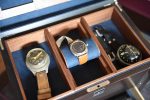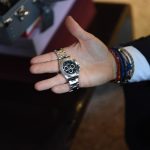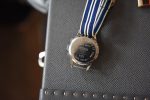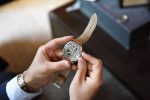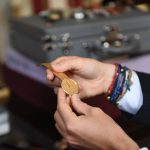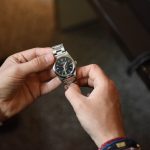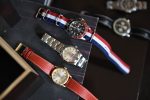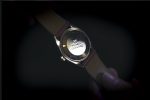Bamford Watch Department
An Engineer’s Obsession: George Bamford
For anyone involved in construction engineering, the name Joseph Cyril Bamford is legendary. For anyone outside the industry, his initials – JCB – represent one of the most recognised brands on the planet. Put those letters in situ in black letters against an orangey- yellow background and even a child will know what they are looking at: a piece of machinery made by one of the biggest family-owned companies in the world.
“I come from an engineering family,” says Joseph’s grandson George Bamford. “At the age of eight, I learned how an engine works. I was on the shop floor of my family’s business learning how to weld. I loved engineering, I loved the idea of building, I loved the idea of design. I hope my parents forgive me for sharing this story but, as a child, they used to lock me in my bedroom at night because I was always an early riser – I used to get up at about 5am and go downstairs and if we had a juicer or a television or anything, I used to take it to bits. I used to try and figure out how it worked. And that’s how my brain is, I always ask: ‘Why can’t I do it?’”
And so when Bamford was given a pre-owned Breitling Navitimer for his 16th birthday in 1996, it sparked his imagination. “It enlightened me,” he says. “My father bought me and my brother one each for £270 and I just got obsessed. I used to sit and look and try and line up the numbers. It wasn’t perfect – I knew the hands weren’t right. I remember I thought it was waterproof because I had only had Swatch watches before. I took it swimming and I was like: ‘Shit, it’s full of water.’ I had to take it to bits and dry it out.”
Unsurprisingly, the Bamford family motto is Jamais Content (Never Satisfied). Bamford believes it is this constant striving to always look for ways to improve something that led him to deconstruct his beloved Breitling. “The first time I took the glass off it, it was the scariest point in my life. There wasn’t any Google back then to give me tips, I was basically just working blind.” Bamford pushes the watch under my nose. “You see in here, you see all the little chip marks, the little line marks? I have a love affair with every dent. I had a little toolkit and wiggled a screwdriver in until it went ‘clunk’. Watchmakers would hate how I did it, but I learnt.”
From this first Breitling experience began an obsession, and Bamford started trading. “It was just small things, whatever I could afford. I used to buy a piece at a flea market and then trade it back to someone and get two more just because I wanted to open the cases and see the different movements. And I was – I am – a magpie. This was the mid-1990s and you could pick up Monacos, Autavias, Speedmasters, and so on very cheaply.
“People would look at me quizzically and ask: ‘Why would you buy a Bullhead?’ And I was like: ‘Because I want to.’ I wanted to understand why the movement was that way around. Gradually I started to respect watches more and instead of yanking things open I would study them and say: ‘OK, I understand this, I understand why they’ve done this.’
“My collection is predominantly one of old buys. I bought them cheaply and I amassed them in a very short period of time,” he says, as he disappears head first into a custom safe that stretches from floor to ceiling. The safe is stuffed with timepieces – just a third of Bamford’s sublime collection. “Now I look at the watch market and I think: I can’t afford this.’”
A gift from his father and the watch that ignited his passion for timepieces, I suggest that the Breitling must surely be the most treasured piece in his collection? Bamford shakes his head emphatically. “The most important is this one,” he says picking up a Rolex Milgauss. “My father never believed in a free ride. He brought my brother and me up to go out, do our own thing and make our own money. I bought this the first time I made a good amount of money. I always loved the idea of the thousand gauss, the double case, the matte blue dial. For me the Milgauss embodied a Rolex – it was affordable, but it was rare, and I loved the idea of this rarity.
“If tomorrow I had to get rid of all my watches bar one, this is the piece I’d keep. People talk about watches being a love affair – with a vintage piece like this, it’s been someone else’s love affair but now it’s mine and it’s got my dings and my dangs. It kind of encapsulates everything that has happened in my life since I bought it. The day I got engaged to my wife I wore it, the day I got married, the days both my children were born, so it holds many memories for me.”
A Lesson Learned
The one watch Bamford credits with having taught him more than any other is his first Rolex GMT with Bakelite bezel.
Knowing the full story of its pedigree I ask permission to photograph it. Bamford contorts his face as he thinks about it and then answers: “Go for it, but this is hard for me. It’s like gambling – gamblers always hate telling you when they’ve lost.
“This and my Milgauss are the only two watches that stay with me at all times. This one faces me most days, and the reason is it tells me: ‘Don’t be a silly idiot.’ I was desperate for a Bakelite GMT, I mean literally desperate. I had to have one and was willing to spend £10,000, which is a lot of money. A dealer found this for me in Italy and at first I was like: ‘This is absolutely amazing! I love it, I love it.’”
Gradually it dawned on Bamford that something wasn’t right. “It is actually a proper Rolex because it’s got a Rolex movement, but everything about it is wrong, every single thing. It is the totally wrong colour, it’s a plastic bezel and the bezel doesn’t t the crown so the crown is actually pushed out. I mean Jesus Christ you look at the printing on the dial you go: ‘What the hell is it?’ If you run a UV light over the whole thing, you’ve got three different colours of lume – I didn’t even know there were three different colours, but there are on this dial! It is not a fake as such but, oh my, it is franken everything. They have taken a cheap Rolex, and they’ve made it into a rare Rolex, so their profit margin was huge.
“When I bought it I thought my knowledge was amazing; I felt like: ‘Yeah I can do this. I know all about watches.’ I started wearing it and it didn’t feel right – I always feel things and it just didn’t feel… Rolex. This watch is like my string of worry beads.
“So this was the biggest learning curve ever for me. I did go back to the dealer and get some money back – I could have asked for it all but this was my ‘egg on my face’ and I wanted to keep it. It taught me so much. When I went on the hunt for my new GMT, I had to have the original box, papers, swing tag, the original receipt, everything. I now have a proper one but I will always keep this one because it was the watch that made me go: ‘Shit.’
Double Dipping
“Now if I want to buy something, I look at it and go: ‘OK, what do I want and how do I want it? What am I going to accept? Do I want box and papers? What can I accept out of my tick list?’ This means that there is no doubt – I know what my minimum requirements are.”
To make his point, Bamford hands me a 1970s stainless- steel GMT with an “AB Trucking Co.” logo dial. Rare to find a co-branded dial on a sports watch of the era, the AB has similar appeal to the COMEX, but without the prohibitive price tag. “I probably paid a premium of about £700,” he confirms.
“I accept this £700 increase,” he continues. “If you said to me, ‘Rolex didn’t produce a dial for AB’, I’d be OK with that. I don’t imagine anyone else would have produced it but it’s one of those things that I have accepted. I love the watch and I don’t give a shit. And if I accept that then it doesn’t matter if it goes up in value or not, it makes me smile when I put it on my wrist.”
Co-branding, it seems, is one of Bamford’s idiosyncrasies – from Tiffany Pateks to Cartier Rolexes. “I look at them and wonder how the hell these partnerships came about. And then there are the branded dials that just seem bizarre. I mean nowadays could you imagine Rolex going: ‘Oh yeah, let’s do a Domino’s Pizza dial’?”
The Coca-Cola dial is followed by a Cartier dial GMT and then a Tiffany GMT. “I have quite a few co-branded pieces,” Bamford smiles. “Rolexes obviously, but then there are the Cartier Jaegers… I have a white-dial steel piece and a larger one with gold dial. They are similar but different, but the dual dial branding makes them special. They are both alarm watches and are so cool.”
Multi Stories
As Bamford continues to – literally – throw watches across the table to me, I ask how he feels about bumps and scratches to his timepieces. He shrugs. “There should be some dings and dents and bashes and there should be some love that has gone into creating each one. Watches are not show ponies; they are not delicate little things. Why do I put a strap on a Rolex? So I can wear it – that’s why I put so much effort into the straps I choose and design.
“I don’t understand people who fear a scratch – it just ruins the pleasure of wearing a watch. I look at an ‘imperfection’ and I embrace it. I remember specific stories. For example, once while driving my old Land Rover Series Three with my hand out the window, I hit a bump and knocked my watch. I thought: ‘Oh shit, I’ve probably scratched it’. And you know what? I love those little dings.”
To prove the point that every watch has its own story, Bamford passes me a generic- looking chronograph. The dial branding reads “Agir”, it’s cool but nothing special. “Now look at the back,” says Bamford. “It was presented to one of his racing drivers by Enzo Ferrari in 1951, and that transforms it into a very special watch.”
Another watch with a story is one that seems very un- Bamford: his grandfather’s gold Corum coin watch, an object of pure blingy beauty so removed from the majority of what is on show during my visit. “I do love it but more for its history. My grandfather gave it to my father and my father gave it to me. My grandfather also had a steel and gold Submariner and I always remember that on his wrist, but when he died it disappeared. With this, it’s that thing about the soul of a watch again – to understand that it was on his wrist; that it was given to me by my father. It’s so 1970s, it just couldn’t be made today.”
Then there is the 1950s Rolex Panerai, that takes pride of place among a set of Panerai dive tools in a custom-made display box. “My wife bought the torch for me one Christmas,” Bamford explains. “The compass, I brought at a German watch fair. I was already buying a load of stuff from a guy and I saw it lying there. I said: ‘OK, I’ll take all of that if you let me have the compass.’ He said: ‘Yeah, yeah, fine. You can just take it because it’s worth nothing.’
“The altimeter I bought from a dealer in Egypt. But the dagger, that’s the real story here. I’ve got the original box and photographs of the Navy guy who owned the watch, and through the paperwork I was able to trace the exact type of dagger. This one is not the original one that went with the watch but it is almost identical. An antique dealer friend of mine knew I was looking and called me from a German military fair to say he’d found it. Best of all, the seller only wanted £15 for it.”
For Bamford it is all about vintage styling and he believes many brands are missing a trick by not looking to their archives. “If watch brands were on their game, they would all be revisiting the 1990s and the 2000s,” he says. “This is why Tudor is cleaning up at the moment because it is serious about heritage. Brands need to look at the past to see the future. That said, I love what Rolex is doing. When the new black GMT came out I was the first one to buy it, same with the gold Yacht-Master on rubber strap, the Air- King and, of course, the new ceramic bezel Daytona.”
Despite astonishing prices being fetched on certain auction lots in recent years, he believes that the vintage world still offers real investment opportunity. “Yes there have been crazy prices on some rare Pateks,” he says. “But I really don’t think that vintage watches have achieved their full potential yet. Watches are art and at some point the art collectors are going to turn to the watch market. This is when we will see great design truly appreciated and prices begin to rise. If you look at some pieces of art, they’re worth fortunes, I mean millions and millions, and some watches are rarer than those. And when the art world comes to realise this, I think that watch prices will y even further.”
However, he does say that the top end of the vintage market is now becoming too rich for him. “Even if I was worth fortunes and fortunes, I have a top price in my mind that I will pay for a watch and, looking at Rolex and Patek Philippe, I’m priced out. I look at the auction catalogues and they’re the thickest things I’ve ever seen and they’re achieving massive prices with massive margins and in my mind I always ask: ‘Am I being ripped off here?’ Collecting really is an obsession but, to be honest, the brand doesn’t really matter. If I were starting today I probably wouldn’t go for the Rolexes, Pateks and APs. I just love good design and now I’m looking at Eberhard, Doxa and Fortis.
“I’m not an expert and I don’t obsess about dates, references and serial numbers,” Bamford says as we end our morning of going through part of his collection. “I’m a magpie, an obsessive – and I just know what I love.”





